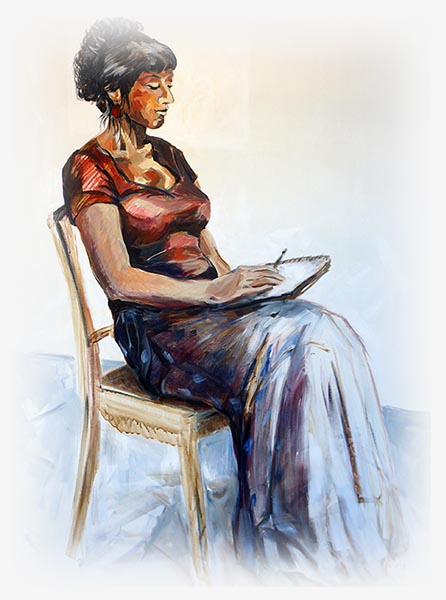By Luis PORQUET (2016)
Originally from Villers-Bocage,
Canter Briens pursued a solid education that, from the Fine Arts School of Caen, took him to a National Diploma in Fine Art, major in engraving, which he was presented in Rouen. He subsequently attended the engraving workshops of Misters Cami and Coutard at the Ecole Nationale Supérieure des Beaux-Arts in Paris. And as if that experience was not enough, he simultaneously studied a Master’s degree in Visual Arts in Paris and a Master’s in Human Sciences at the University of Caen. Swept along by the momentum, he quite naturally took on a further post-graduate degree in Sociology.
Equipped with these strangely complementary assets, this painter, engraver and visual artist was able to develop his qualities of observation, analysis and reflection in relation to painting and to the contributions that art can make in the fields of therapy, communication, the emotional environment and self-expression. After all, when well thought through, the adventure of aesthetics takes into account a large number of facets and attributes of the human being, including its relation with the world and place in society, as well as its cognitive search for well-being. What use would art be if it did not imply some sort of accomplishment, and even a surpassing of oneself?
Developing an artistic practice does not really assume meaning unless the experience results in a better understanding of others, their own questions and their incessant need to give real meaning to their lives.
A glimpse at Canter Briens’ multi-faceted personality through his artworks and notes reveals him as a sort of go-between. Capturing and “visibly representing the sources of energy that produce shapes” is one of the objectives he has fixed himself. He is always seen to be searching for knowledge and concerned with the human being in its entirety, and he accords it considerable importance in his artwork, it is true, his portraits unveiling a whole new angle of his thought process. Claiming first and foremost to be a figurative artist, though bordering on an abstract form of self-expression at times (a case in point being his watercolours enhanced with acrylic, in which he flirts with writing and offers a more diluted image of the landscape than usual, as though portraying a fusion between the natural elements and the inner lives of beings), Canter Briens also practices neuro-linguistic programming (communication techniques) whilst demonstrating an interest in the workings of the subconscious. This just shows the vastness of his chosen field, the hidden secrets of which he is attempting, alone, to uncover.
Is not the sea, which is relatively present in his painting, the incarnation of the common origin of all life; the matrix substance where primitive forms were born before giving birth to our earliest ancestors? “At times,” he says in a poem, “the backcloth stretches towards the horizon and signs appear like wings.” Learning to see shapes emerging amounts to immersing oneself in the space and movement of the universe.
